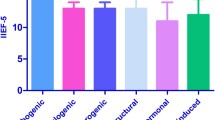Abstract
An abridged five-item version of the 15-item International Index of Erectile Function (IIEF) was developed (IIEF-5) to diagnose the presence and severity of erectile dysfunction (ED). The five items selected were based on ability to identify the presence or absence of ED and on adherence to the National Institute of Health's definition of ED. These items focused on erectile function and intercourse satisfaction. For 1152 men (1036 with ED, 116 controls) analyzed, a receiver operating characteristic curve indicated that the IIEF-5 is an excellent diagnostic test. Based on equal misclassification rates of ED and no ED, a cutoff score of 21 (range of scores, 5–25) discriminated best (sensitivity=0.98, specificity=0.88). ED was classified into five severity levels, ranging from none (22–25) through severe (5–7). Substantial agreement existed between the predicted and ‘true’ ED classes (weighted kappa=0.82). These data suggest that the IIEF-5 possesses favorable properties for detecting the presence and severity of ED.
Similar content being viewed by others
Author information
Authors and Affiliations
Rights and permissions
About this article
Cite this article
Rosen, R., Cappelleri, J., Smith, M. et al. Development and evaluation of an abridged, 5-item version of the International Index of Erectile Function (IIEF-5) as a diagnostic tool for erectile dysfunction. Int J Impot Res 11, 319–326 (1999). https://doi.org/10.1038/sj.ijir.3900472
Received:
Accepted:
Published:
Issue Date:
DOI: https://doi.org/10.1038/sj.ijir.3900472
- Springer Nature Limited
Keywords
This article is cited by
-
ManAgement of pRiapiSm and its impact on outcomes: an international register (MARS study) – the first international, multicenter, observational study regarding priapism in perspective
International Journal of Impotence Research (2024)
-
Cold hypersensitivity in the hands and feet is associated with erectile dysfunction in young Taiwanese men
Scientific Reports (2024)
-
Efficacy of top flat magnetic stimulation for chronic pelvic pain in men: preliminary results
International Journal of Impotence Research (2024)
-
Effect of bulbospongiosus muscle injection with botulinum-A toxin for treatment of lifelong premature ejaculation; a randomized controlled trial
International Journal of Impotence Research (2024)
-
The association of smoking with urinary and sexual function recovery following radical prostatectomy for localized prostate cancer: a systematic review and meta-analysis
Prostate Cancer and Prostatic Diseases (2024)




